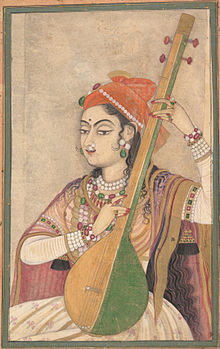Music of Jammu and Kashmir
| Music of India | |
|---|---|

A Lady Playing the Tanpura, ca. 1735 (Rajasthan)
|
|
| Genres | |
|
|
| Media and performance | |
| Music awards | |
| Music festivals | |
| Music media | |
| Nationalistic and patriotic songs | |
| National anthem | Jana Gana Mana |
| Regional music | |
|
|
Kashmiri music (Urdu: جموں اور کشمیر کے سنگیت) reflects the rich musical heritage and cultural legacy of Kashmir. Traditionally the music composed by ethnic Kashmiris has a wide range of musical influences in composition. Due to Kashmir's close proximity to Central Asia, Eastern Asia and Southern Asia, a unique blend of music has evolved encompassing the music of the three regions. But, overall, Kashmiri Valley music is closer to Central Asian music, using traditional Central Asian instruments and musical scales, while music from Jammu is similar to that of North India and Ladakhi music is similar to the music of Tibet.
Chakri is one of the most popular types of traditional music played in Jammu & Kashmir. Chakri is a responsorial song form with instrumental parts, and it is played with instruments like the harmonium, the rubab, the sarangi, the nout, the geger and the chimta. It is performed in folk and religious spheres, by the Muslim and Hindu kashmiris. Chakri was also used to tell stories like fairy tales or famous love stories such as Yousuf-Zulaikha, Laila-Majnun, etc. Chakri ends with the rouf, though rouf is a dance form but few ending notes of Chakri which are played differently and on fast notes is also called Rouf. It is a very important part of the Henna Night during weddings.
Rouf is a traditional dance form usually performed by women on certain important occasions like marriage and other functions and also in cultural activities.
Ladishah is one of the most important parts of the Kashmiri music tradition. Ladishah is a sarcastic form of singing. The songs are sung resonating to the present social and political conditions and are utterly humorous. The singers move from village to village performing generally during the harvesting period. The songs are composed on the spot on issues relating to that village, be it cultural, social or political. The songs reflect the truth and that sometimes makes the song a bit hard to digest, but they are totally entertaining.
...
Wikipedia
